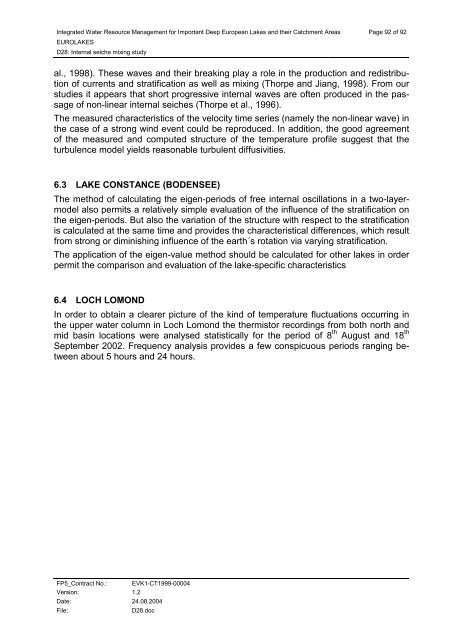D28: Internal seiche mixing study - Hydromod
D28: Internal seiche mixing study - Hydromod
D28: Internal seiche mixing study - Hydromod
You also want an ePaper? Increase the reach of your titles
YUMPU automatically turns print PDFs into web optimized ePapers that Google loves.
Integrated Water Resource Management for Important Deep European Lakes and their Catchment Areas<br />
EUROLAKES<br />
<strong>D28</strong>: <strong>Internal</strong> <strong>seiche</strong> <strong>mixing</strong> <strong>study</strong><br />
FP5_Contract No.: EVK1-CT1999-00004<br />
Version: 1.2<br />
Date: 24.08.2004<br />
File: <strong>D28</strong>.doc<br />
Page 92 of 92<br />
al., 1998). These waves and their breaking play a role in the production and redistribution<br />
of currents and stratification as well as <strong>mixing</strong> (Thorpe and Jiang, 1998). From our<br />
studies it appears that short progressive internal waves are often produced in the passage<br />
of non-linear internal <strong>seiche</strong>s (Thorpe et al., 1996).<br />
The measured characteristics of the velocity time series (namely the non-linear wave) in<br />
the case of a strong wind event could be reproduced. In addition, the good agreement<br />
of the measured and computed structure of the temperature profile suggest that the<br />
turbulence model yields reasonable turbulent diffusivities.<br />
6.3 LAKE CONSTANCE (BODENSEE)<br />
The method of calculating the eigen-periods of free internal oscillations in a two-layermodel<br />
also permits a relatively simple evaluation of the influence of the stratification on<br />
the eigen-periods. But also the variation of the structure with respect to the stratification<br />
is calculated at the same time and provides the characteristical differences, which result<br />
from strong or diminishing influence of the earth´s rotation via varying stratification.<br />
The application of the eigen-value method should be calculated for other lakes in order<br />
permit the comparison and evaluation of the lake-specific characteristics<br />
6.4 LOCH LOMOND<br />
In order to obtain a clearer picture of the kind of temperature fluctuations occurring in<br />
the upper water column in Loch Lomond the thermistor recordings from both north and<br />
mid basin locations were analysed statistically for the period of 8 th August and 18 th<br />
September 2002. Frequency analysis provides a few conspicuous periods ranging between<br />
about 5 hours and 24 hours.









